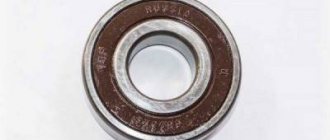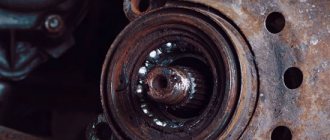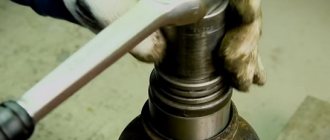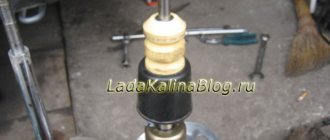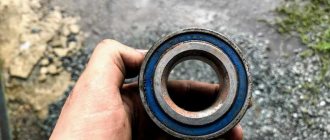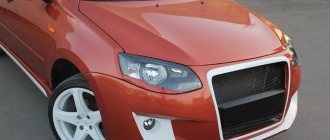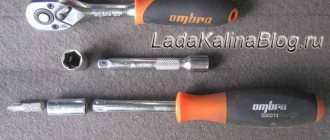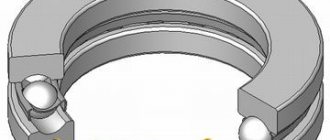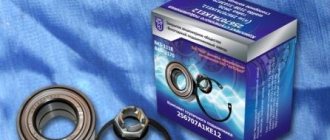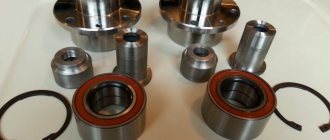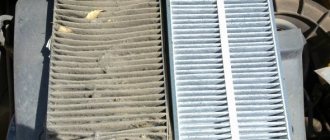Rear wheel bearing on Kalina: design features and typical faults.
Algorithm for replacing the rear wheel bearing on Kalina with photos and videos. The Lada Kalina rear wheel bearing is a resource-intensive part (the bearing remains functional at levels up to 200,000 km and above), however, Russian operational realities reduce the resource potential and the bearing often fails even on relatively new cars. The breakdown is that the bearing cage falls apart and the rollers get knocked to one side.
Signs of a bad wheel bearing
The rear wheel bearing on Kalina wears out gradually. Instant breakdown is possible in the event of a traffic accident. Excessive wear has virtually no effect on the driving performance of the car. You can suspect impending bearing failure by an uncharacteristic hum that appears in the rear wheel area when driving.
In this case, the hum appears only when the spare part is worn out. Moreover, immediately before a breakdown, the hum increases and turns into a permanent crunch; problems with handling begin - the car drives from side to side. In the early stages, a breakdown can only be diagnosed using service equipment.
Comments
TOP materials of the week
TOP products in the store (more)
Are you satisfied with the standard low beam of the Lada Priora?
Lada.Online
Lada (“Lada”) is a brand of cars produced by JSC AVTOVAZ. Previously, it was used only for export cars, and for the domestic market, cars were produced under the Zhiguli brand. In 2004, the management of AVTOVAZ announced the transition to the Latin alphabet for the official spelling of the names of all cars produced by the plant: Lada - instead of "VAZ" and "Lada".
Lada.Online is the largest Russian-language automotive resource with a daily audience of thousands, which is dedicated primarily to cars of this brand, the domestic automotive industry and the automotive world in general.
This site is not the official LADA website.
© 2022 Lada.Online. Copying of material is permitted only with a link to the source.
Source
Causes of rear wheel bearing failure on Kalina
There are a number of factors that contribute to wheel bearing failure. The most common:
- a traffic accident or other sudden mechanical impact on this part of the car;
- over-tightening of the tapered bushing;
- systematic overheating of the part;
- factory defects (incorrectly set gap);
- bearing seal failure;
- the use of low quality lubricants or lack of lubrication in the unit.
Troubleshooting
As noted above, a constant hum is the main sign that the wheel bearing has become unusable. Extraneous sounds begin to appear at speeds of 40-60 km/h. Another old-fashioned diagnostic method is tapping the tires with your foot. If the wheel wobbles or there is play, then most likely the hub is faulty.
You can also check the serviceability of the element by hanging the back of the Lada and rotating the wheel. Play, crunching, and vibrations in a suspended wheel will indicate a hub failure.
Buying a new part
The components for the rear wheel hub are unified, so they are suitable not only for Kalina, but also for Granta and Datsun. Depending on the manufacturer, the cost of a set of parts will be in the range of 600-1100 rubles.
Why is the hub humming?
There are actually several reasons why a hum or knocking noise occurs in the wheel bearing area. Thus, unpleasant creaking sounds can be a sign of partial failure of the steering rod, tip, ball joint, worn silent blocks, as well as directly from the wheel bearing. And it is the bearing that most often causes the hum.
A closed type of bearing is used as a wheel bearing. This is due to the fact that when the car is moving, it is impossible to allow sand, dirt, dust and other abrasive elements to get into the bearing housing. In general, there are six main reasons why a situation may arise when a wheel bearing partially fails and begins to creak.
- Significant mileage . This is a natural reason why the inner surface of the bearing housing wears out, causing the grooves for the balls in it to expand and the bearing begins to knock. This usually happens after 100 thousand kilometers (depending on the specific car, bearing brand, and how you drive the car).
- Loss of tightness . The closed-type bearing housing has rubber and/or plastic casing inserts that cover the bearing balls from the external environment. The fact is that inside the bearing there is a small amount of lubricant that ensures its normal operation. Accordingly, if such inserts are damaged, the lubricant leaks out and the bearing begins to run “dry”, and accordingly, sudden wear occurs.
- Sloppy driving . If a car often flies into holes, potholes, or bumps at high speed, then all this breaks not only the suspension, but also the hub itself.
- Incorrect pressing . This is a fairly rare reason, however, if during a previous repair the bearing was installed by an inexperienced (or unqualified) person, then it is quite possible that the bearing was installed diagonally. Under such conditions, the unit will operate for only a few thousand kilometers.
- Incorrect hub nut tightening torque . The technical documentation for the car always clearly indicates with what torque the hub nut must be tightened and sometimes how to tighten it to adjust the hub. If the torque value is exceeded, it will begin to overheat while driving, which will naturally reduce its resource.
- Driving through puddles (water) . This is a rather interesting case, which lies in the fact that when driving, every bearing, even a serviceable one, heats up, and this is normal. But when entering cold water, the air inside it is compressed and through not very dense rubber seals it itself sucks moisture into the bearing housing. This is especially true if the rubber bands are already old or simply rotten. Moreover, the crunch itself usually does not appear immediately, but may appear after one or two days, when corrosion, albeit small, forms directly in the bearing.
In addition to those listed above, there are a number of less common reasons why the wheel bearing begins to crunch when driving:
- Manufacturing defects . This reason is relevant for inexpensive bearings made in China or Russia. This can be expressed in different ways. For example, inaccurate adherence to dimensions and tolerances, poor-quality sealing (seal), insufficient special lubricant.
- Incorrect wheel rim offset . This naturally leads to increased load on the wheel bearing, which shortens its life and can lead to the appearance of a crunching noise in it.
- Frequent operation of an overloaded machine . Even if the car is driven on good roads, it should not be overloaded significantly and/or often. This similarly leads to increased load on the bearings with the consequences mentioned above.
- Tire radius too large . This is especially true for jeeps and commercial vehicles. If the tire diameter is large, then during lateral acceleration an additional destructive force will act on the bearing. In particular, on the front hubs.
- Faulty shock absorbers . When the car's suspension elements do not cope with their tasks properly, then when driving on bad roads, the load on the hub bearings increases in the vertical plane, which reduces their overall service life. Therefore, you need to ensure that the car’s suspension operates normally. Especially if the car is often driven on bad roads and/or is often heavily loaded.
- Malfunctions in the brake system . Often, the brake fluid temperature and/or brake rotor (drum) temperature will be high and heat energy will be transferred to the wheel bearing. And overheating reduces its resource.
- Incorrect wheel alignment/camber . If the wheels are installed at incorrect angles, the load forces will be incorrectly distributed to the bearings. Accordingly, on one side the bearing will experience overload.
How to change the rear wheel bearing on Kalina
Before you begin the replacement procedure, you need to give the car a working position - hang the rear wheels, while securely fixing the front ones. It is enough to post only the side on which repair work is planned. Next, we sequentially follow the algorithm outlined below:
- We unscrew the wheel bolts and remove the wheel from the “damaged” side;
- Remove the nut in the center of the hub and the cap;
- Lightly tap the guide bolts with a hammer and then remove them;
- We dismantle the brake drum: before the procedure, it is recommended to treat the fasteners of the part with VD-40 (for these purposes, car shops have special drum pullers);
- After dismantling the drum, access to the central nut opens. We remove it;
- Push back the hub axle to gain access to the bearing races. Before proceeding with dismantling, you need to carefully inspect the unit. If there are signs of bearing rotation on the axle, then the hub is not suitable for routine repairs - replacement is required;
- Use pliers to pull off the hub retaining ring; after this, the edge of the ring is thoroughly coated with “Vedashka” or liquid to remove corrosion spots;
- Now you can remove the hub completely and remove the race with bearings. The part can be removed using a special press or puller. But most “experienced” people simply knock out the cage with a sledgehammer, having first secured the hub in a vice;
- The bearing seat is cleaned of dirt, rust, etc. using sandpaper. Then the landing niche must be treated with lubricant: used motor oil is quite suitable.
- Now you need to start “driving” the new bearing into the hub. First, place the hub on a flat, hard surface;
- The new bearing is generously lubricated with a special lubricant (the specification of the lubricating fluid can be clarified in the vehicle’s operating manual. Using a lubricant that does not meet the operating requirements accelerates the wear of this chassis element);
- Now you can “drive” the part into the hub. This is done using a light (up to 1.5 kg) hammer: the cage is easily tapped around the circumference, the bearing is gradually immersed inside the hub. Caution should be exercised as the double row bearings may crack if applied with excessive force. In this case, before installation, it is recommended to apply a series of gentle blows to the part in order to further compress the bearing;
- The bearing must be tapped so that there are no distortions while it is being inserted into the working hole. You can use the clip of the old component to guide the movement of the working part;
- When the bearing reaches its extreme position, put the retaining ring in place. But before this, you must check that the bearing has reached the “bottom” of the hub;
- Replacement of the Kalina rear wheel bearing is completed.
Upon completion of the work, you need to hang the car and rotate the wheel. If there is no noise or crunching, the hub is “healthy”.
Helpful advice
When purchasing a new bearing, it is important to check that it contains grease. Often unscrupulous manufacturers do not report it to the required level. As a result, the element is constantly subjected to stress and fails.
It is not uncommon for a part to break down after 3,000 km (especially on UAZ vehicles). The best option is to gut out all the existing grease and apply a new one, purchased separately. Fortunately, specialized lubricants are now sold. They are resistant to washout and do not change properties at high temperatures.
Typical symptoms
This is the most interesting thing. In order to determine the failure of a node, there are several ways. At the very initial stage, the behavior of the bearing can be ignored; at this stage, a slight hum, buzzing, and small tapping noises can be heard. Also, one of the first symptoms is a hum when turning (at the very initial stages of a breakdown). This sound is often confused with tire noise. However, over time the sound can be compared to a jet plane. An indirect sign can be considered the complete disappearance of any noise at the moment of turning, but when the car moves in a straight line, everything returns.
Bearing 256707
Its main area of application is the front wheel bearing of VAZ 1118, 2190 and other models of this series produced by the Tolyatti Automobile Plant. It has the following design characteristics - ball, angular contact, double-row, closed type (seals on both sides and with plastic lubrication). Since it has two rows of rolling elements, it is capable of fixing the shaft under axial load in both directions. There is a roller analogue of this bearing - 537807, it has an increased load capacity, but a lower rotation speed; its use may be more advisable on our roads, which are not characterized by smooth surfaces. The smaller bearing 256706 is installed in the rear hubs of the predecessor models of Granta and Kalina. Full product marking - 6-256707EK12 or AEKL20 (there may be others, primarily Vologda ones, but, by and large, there is not much difference)
Replacing the front wheel hub bearing
The work can be carried out on a flat area, but it is more convenient on an inspection ditch or overpass. You can replace the bearing in two ways - on the car, without removing the steering knuckle and thereby not disturbing the wheel camber angle, or by first removing the steering knuckle. The work is shown on the right wheel bearing. The left wheel hub bearing is replaced in the same way. Loosen the wheel mounting bolts.
. and remove the protective cap of the wheel hub, which is fitted with a rubber O-ring.
Articles
We do not recommend our native article. We also don't recommend Pileng. He didn’t even travel 7,000 km with us. We installed a spare CRAFT 256706.
The original article number of the CRAFT bearing is 256706.
Many manufacturers also use this article:
READ Toyota Camry 2022 Which Gasoline to Fill
Also suitable: SKF BA2B 633313 C.
Step-by-step procedure for removing the hub
- First of all, while the car is still on its wheels (details on bolt diagrams and typical wheel sizes), you need to remove the nut that secures the hub.
We tear off the nut with a wrench with an extension.
We tighten the puller tightly, eliminating the possibility of slipping.
This is what the removed bushing and bearing assembly looks like.
Causes and consequences
If this is not done on time, this can lead to a minimum of sudden blocking and uneven wear of the wheel, and accordingly further damage, and at most it can lead to a traffic accident.
In this article we will tell you in detail how to replace the bearing on the rear hub of a Lada Kalina car with your own hands in a garage.
Note!
Lada Kalina cars are equipped with a double-row ball bearing, which during operation does not require additional lubrication or adjustment; just to say, this device does not require any maintenance during the entire period of its operation.
see also
Comments 11
I recently organized a company to sell bearings. So I can say with confidence - take Vologda (VBF). Price/quality is the best combination
How long is the warranty on bearings? I mean, maybe this is a warranty issue...
It is not necessary to change both; in my opinion, there is no difference in what to install, the only difference is who installs it.
Well, there are such specialists))
Take the Vbf, it’s not necessary to change them in pairs, take the front ones in their original “Lada Detail” packaging with a metal boot
Thanks, I'll take the second one in reserve
Wheel bearings, if I'm not mistaken, have no service life. Those. they need to be changed after the fact. If it’s over on one side, then the other might already be on its way. Logically, you need to change them in pairs, that is. But, considering that the stores now sell the hell out of them, both Chinese and counterfeit ones under branded ones and in general the devil is bald, then take a pair, and change only the one that is already there, and put the second one in reserve. Maybe the second factory one is still similar, after all, they put it on the assembly line better, as they say. As they say, if you change the factory ones, you’ll keep changing them in circles. And what kind of bearings - take your Yaroslavl ones, if you still make them))))
I haven’t even heard anything about Yaroslavl bearings))
Removing the hub from the car axle shaft
So, the first step, when the car is still on wheels, is to rip off the hub nut by first prying up and removing the protective plastic cap in the center of the wheel.
We also tear off the wheel rim bolts, and after lifting the car with a jack, we finally turn them out. In principle, the pads do not need to be removed, but I carried out the work when they were no longer there. Unscrew the rear hub nut completely, as shown in the photo:
Then the fun begins. It happens that even with a little hand effort, pulling towards yourself, the hub can be removed from the axle shaft without any problems, but this does not always happen, fortunately. The ideal option for dismantling is to use a special puller with rotary grips. We put it on the hub, grabbing it by the inner part and tighten the central rod of the puller with a wrench, thereby pulling the hub off the axle shaft.
As a result, after a few turns of the bolt, everything can be dismantled without any problems. The final result can be seen below:
There doesn’t seem to be anything difficult with removal, but then it will be a little more interesting, especially without a bearing puller.
What to look for at first glance
1) First you need to understand whether your car comes with or without ABS. After all, the differences here are truly striking. A car with ABS has a bearing with a magnetic washer, but a car without such a washer does not. Previously, one manufacturer could find different configurations of machines.
2) On the edge, either in the upper part or in the lower part, there must be an engraving of the manufacturer, as well as the country of origin; there may also be digital indicators (sizes, for example). If there is no country of origin, DO NOT TAKE IT, most likely it is a fake.
3) The bearing must be supplied with a hub nut; as a rule, it is disposable; on some models, studs (if provided), bolts or pins, and sometimes seals.
